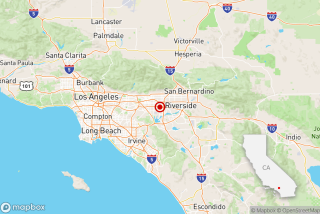5.2 Aftershock in Big Bear Area Rattles Southland
The strongest aftershock of the Landers-Big Bear earthquake sequence in more than a month, a magnitude 5.2 temblor, hit six miles southeast of Big Bear Lake on Monday afternoon, shaking a wide area of Southern California but causing no reported damage.
Scientists at Caltech and the U.S. Geological Survey said the earthquake was very close to the epicenter of the magnitude 6.6 Big Bear main shock, which had followed the 7.5 Landers earthquake, 20 miles east, by just three hours on June 28.
Monday’s aftershock, like the Big Bear main shock, occurred between seven and eight miles underground. If it had been closer to the surface, it probably would have caused some damage and injuries, experts said.
“Deep earthquakes do a lot less damage,” said the Geological Survey’s Jim Mori.
Mori and Caltech’s Egill Hauksson said the aftershock was a vertical thrust earthquake in contrast to the horizontal strike-slip quake of June 28 and probably occurred on a separate, unnamed fault than the earlier Big Bear quake.
On July 8, a magnitude 5.4 jolt hit the same area, causing 16 injuries and some property damage.
San Bernardino County sheriff’s spokesman Jim Cook called Monday’s shaker “a very moderate one” and said his substation received few calls about it.
Mori and Hauksson said the 1:41 p.m. aftershock, which was felt as far south as San Diego County and as far west as Santa Monica, was to be expected.
“It is not remarkable,” said Mori. “People might expect this size aftershock as much as a year after the main shocks. But the 5 magnitude earthquakes are already coming fewer and further between.”
Still, earthquake scientists and the state Office of Emergency Services continue to say that a magnitude 6 aftershock is possible, probably closer to the Landers aftershock zone than to Big Bear.
Weekly seismic maps released by Caltech and the Geological Survey have continued to show a striking triangular pattern of hundreds of aftershocks a week, trending northeast through the Big Bear area or northwest from east of Desert Hot Springs through the Little San Bernardino Mountains, Yucca Valley and Landers.
A separate cluster of apparently related quakes is seen northeast of Barstow, and clusters also extend into the Owens Valley.
The latest weekly earthquake report issued with the maps last Thursday recorded 568 aftershocks for the preceding week, showing that the Landers-Big Bear earthquake sequence remains quite active.
Of the 568 quakes, 63 were magnitude 2.5, which is barely noticeable to people, or larger.
But in terms of effect, a lot depends on the proximity of the quakes to the surface. So, John Foley, a Big Bear resident, reported Monday that a magnitude 3.7 earthquake last week turned the clock on his microwave off, while the 5.2 on Monday did not.
The Geological Survey’s National Earthquake Information Center at Golden, Colo., assigned Monday’s shock a magnitude of 4.7.
But this was based on two seismographic stations, while Caltech reached its 5.2 reading with data from 20 stations. Allan Lindh, Western regional branch chief for the Geological Survey, said it would accept Caltech’s assessment as more reliable.
New Aftershock
Monday’s Big Bear aftershock, assigned a 5.2 magnitude by Caltech, was the strongest temblor in the Landers--Big Bear earthquake sequence in more than a month. But it did little damage because it was centered more than seven miles beneath the surface.
More to Read
Sign up for Essential California
The most important California stories and recommendations in your inbox every morning.
You may occasionally receive promotional content from the Los Angeles Times.










